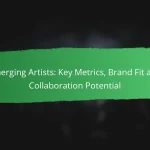Emerging artists in New York City have unique opportunities to collaborate with nonprofits, creating impactful community projects that benefit both parties. These partnerships not only enhance visibility for artists but also provide nonprofits with innovative programming and essential resources. By leveraging their creative skills and shared networks, artists can significantly advance their careers while contributing to meaningful community initiatives.
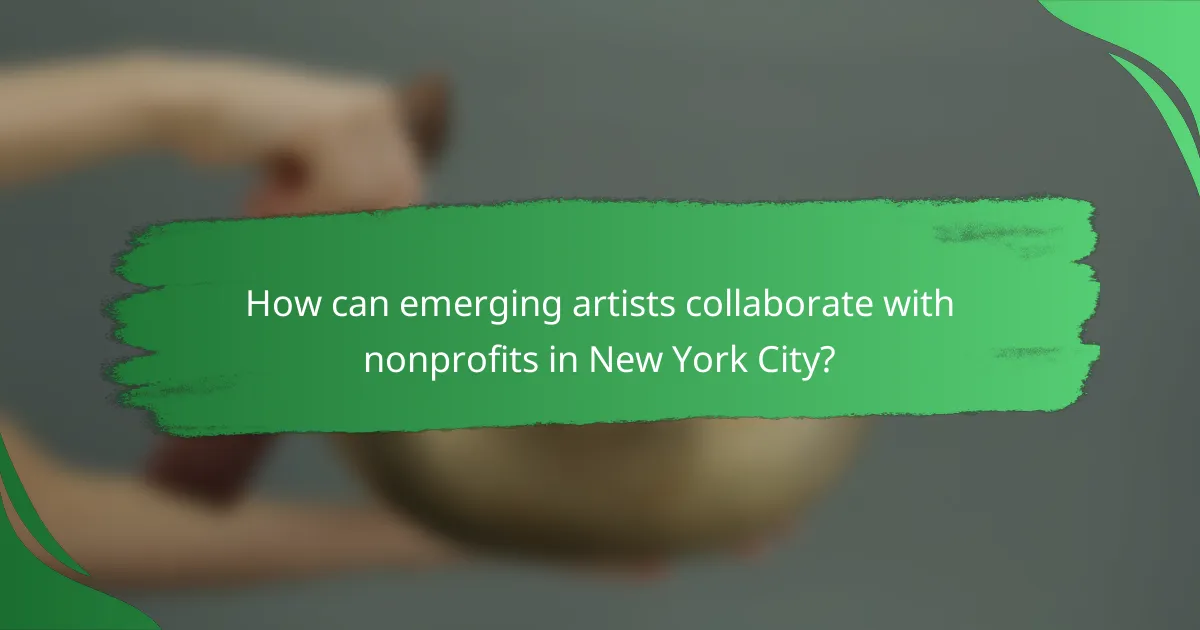
How can emerging artists collaborate with nonprofits in New York City?
Emerging artists can collaborate with nonprofits in New York City by engaging in various programs that leverage their creative skills while supporting community initiatives. These partnerships often focus on mutual benefits, including exposure for artists and resources for nonprofits.
Partnership programs
Partnership programs between emerging artists and nonprofits typically involve joint projects that align with the missions of both parties. For instance, artists may create public art installations that promote a nonprofit’s cause, enhancing visibility and community engagement.
Nonprofits often seek artists for specific campaigns or events, providing a platform for artists to showcase their work. This can include exhibitions, performances, or workshops that not only highlight the artist’s talent but also serve the nonprofit’s objectives.
Community engagement initiatives
Community engagement initiatives are essential for fostering connections between artists and local residents. Artists can lead workshops or educational programs that encourage community participation and creativity, which in turn helps nonprofits fulfill their outreach goals.
These initiatives can take various forms, such as mural projects in underserved neighborhoods or collaborative art events that bring together diverse community members. Such activities not only enhance community spirit but also provide artists with valuable networking opportunities.
Funding opportunities
Funding opportunities for collaborations between emerging artists and nonprofits can come from grants, sponsorships, or crowdfunding campaigns. Nonprofits often have access to funding sources that artists can tap into, especially for projects that align with social causes.
Artists should consider applying for grants specifically aimed at arts and community development. Local foundations and government programs in New York City frequently offer financial support for collaborative projects that benefit the community while promoting artistic expression.

What are successful case studies of artist-nonprofit collaborations?
Successful artist-nonprofit collaborations often leverage the strengths of both entities to create impactful community projects. These partnerships can enhance visibility for emerging artists while providing nonprofits with innovative programming and outreach opportunities.
Project Row Houses
Project Row Houses, located in Houston, Texas, exemplifies a successful collaboration between artists and a nonprofit organization. This initiative transforms vacant houses into art spaces, fostering community engagement and cultural development. Artists are invited to create site-specific works that reflect the neighborhood’s history and culture.
Key considerations for similar projects include securing local support and ensuring that the artistic vision aligns with community needs. Engaging residents in the creative process can enhance ownership and participation, making the project more sustainable.
Art for Change
Art for Change is a nonprofit that partners with emerging artists to address social issues through creative expression. By focusing on themes like social justice and environmental awareness, the organization facilitates projects that resonate with both artists and community members. This collaboration often involves workshops, public installations, and exhibitions that encourage dialogue and action.
To maximize impact, nonprofits should clearly define their goals and select artists whose work aligns with their mission. Providing artists with resources and support can lead to innovative solutions that benefit the community while elevating the artists’ profiles.
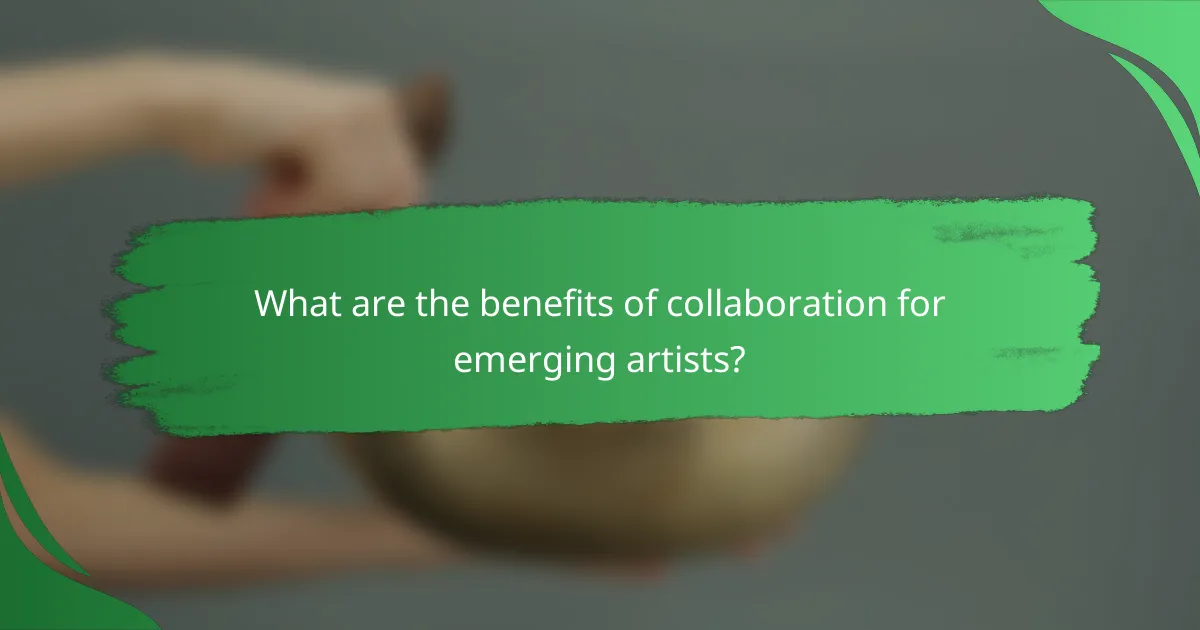
What are the benefits of collaboration for emerging artists?
Collaboration offers emerging artists numerous advantages, including enhanced exposure and access to vital resources. By working with nonprofits and other artists, they can leverage shared networks and knowledge to advance their careers.
Increased visibility
Collaborating with established nonprofits can significantly boost an emerging artist’s visibility. These organizations often have existing audiences and marketing channels that can showcase the artist’s work to a broader public.
For example, participating in a nonprofit’s exhibition or event can attract media attention and potential buyers, leading to increased recognition within the art community. This exposure can be pivotal for artists looking to build their reputations.
Access to resources
Emerging artists often face challenges in securing funding and materials. Collaborating with nonprofits can provide access to essential resources such as grants, studio space, and professional development workshops.
Nonprofits may also offer mentorship programs that connect artists with experienced professionals, helping them refine their skills and navigate the art world more effectively. This support can be crucial for artists in the early stages of their careers.
Networking opportunities
Collaboration fosters valuable networking opportunities for emerging artists. By working alongside other artists and nonprofit staff, they can build relationships that may lead to future collaborations and projects.
Attending joint events or workshops allows artists to meet industry professionals, potential patrons, and fellow creatives. These connections can open doors to exhibitions, sales, and other career-enhancing opportunities.
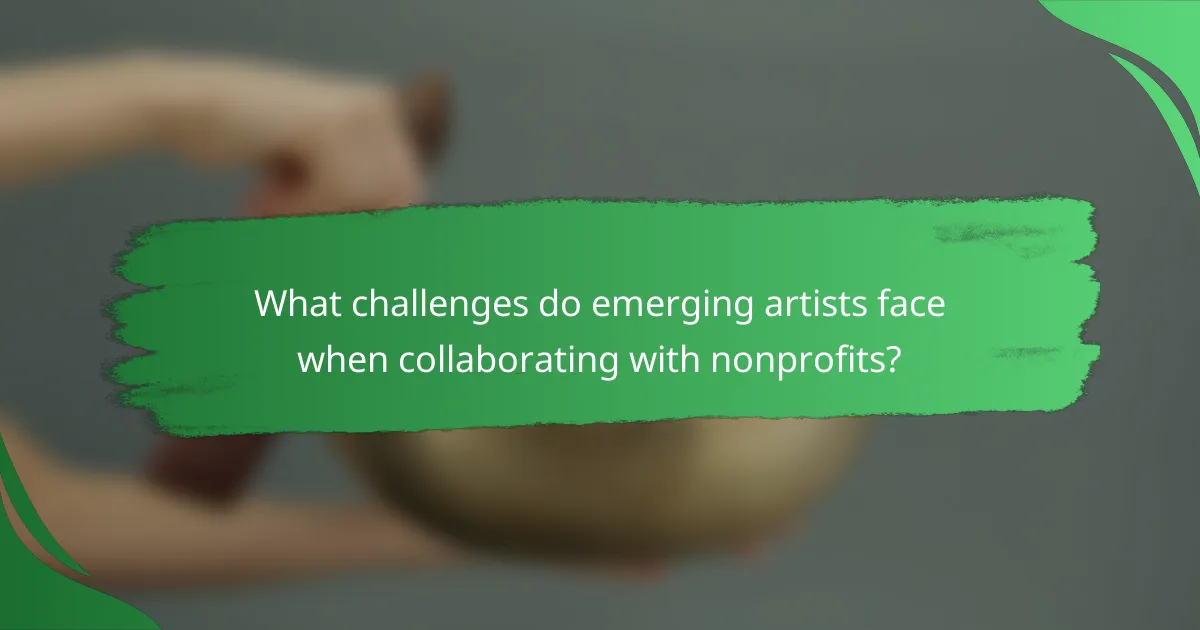
What challenges do emerging artists face when collaborating with nonprofits?
Emerging artists often encounter several challenges when collaborating with nonprofits, including limited funding, resource allocation issues, and communication barriers. These obstacles can hinder the effectiveness of partnerships and impact the overall success of artistic projects.
Funding limitations
Funding limitations are a significant challenge for emerging artists working with nonprofits. Many nonprofits operate on tight budgets, which can restrict the financial support available for artistic initiatives. Artists may find it difficult to secure adequate compensation for their work, leading to potential undervaluation of their contributions.
To navigate funding limitations, artists should consider diversifying their funding sources. This could include applying for grants, seeking sponsorships, or launching crowdfunding campaigns. Understanding the specific funding landscape in their region can also help artists identify potential opportunities.
Resource allocation issues
Resource allocation issues often arise when emerging artists collaborate with nonprofits, as these organizations may prioritize their existing programs over new artistic projects. Limited access to facilities, materials, or administrative support can hinder the execution of artistic visions.
Artists should proactively discuss resource needs during initial negotiations with nonprofits. Clearly outlining what resources are necessary for a successful collaboration can help ensure that both parties are aligned and can work effectively together. Establishing a clear plan for resource sharing can also mitigate potential conflicts.
Communication barriers
Communication barriers can complicate collaborations between emerging artists and nonprofits. Differences in terminology, expectations, and organizational cultures may lead to misunderstandings or misaligned goals. This can result in frustration and inefficiencies in the collaborative process.
To overcome communication barriers, artists should prioritize open dialogue from the outset. Regular check-ins and feedback sessions can facilitate clearer understanding and alignment. Utilizing collaborative tools, such as project management software, can also enhance communication and keep everyone on the same page throughout the project.
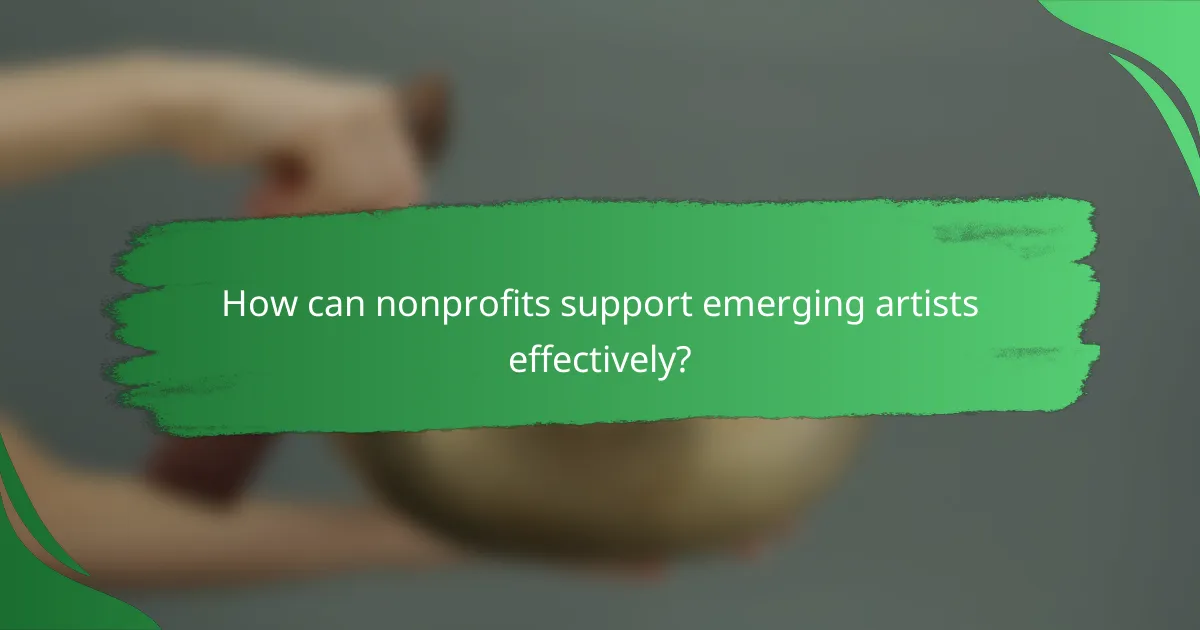
How can nonprofits support emerging artists effectively?
Nonprofits can effectively support emerging artists by providing resources, mentorship, and opportunities that foster their growth and visibility. By focusing on tailored programs, nonprofits can create a nurturing environment that helps artists develop their skills and reach wider audiences.
Providing mentorship
Mentorship is crucial for emerging artists as it offers guidance from experienced professionals in the field. Nonprofits can establish mentorship programs that pair artists with established figures who can provide feedback, career advice, and networking opportunities.
To implement a successful mentorship program, nonprofits should consider the specific needs of the artists and the expertise of the mentors. Regular check-ins and structured goals can enhance the effectiveness of these relationships, ensuring that emerging artists receive the support they need to thrive.
Facilitating workshops
Workshops are an excellent way for nonprofits to provide hands-on learning experiences for emerging artists. These sessions can cover various topics, including technical skills, marketing strategies, and business practices relevant to the art world.
When organizing workshops, nonprofits should aim for a mix of formats, such as in-person sessions and online webinars, to accommodate different learning preferences. Collaborating with industry professionals to lead these workshops can significantly enhance their value and attract more participants.
Offering exhibition spaces
Providing exhibition spaces is a vital way for nonprofits to help emerging artists showcase their work to the public. By offering affordable or free venues, nonprofits can lower the barriers for artists to gain exposure and connect with potential buyers and patrons.
Nonprofits should consider hosting regular exhibitions, pop-up events, or collaborative shows that feature multiple artists. This approach not only diversifies the offerings but also creates a vibrant community atmosphere that encourages networking and collaboration among artists.
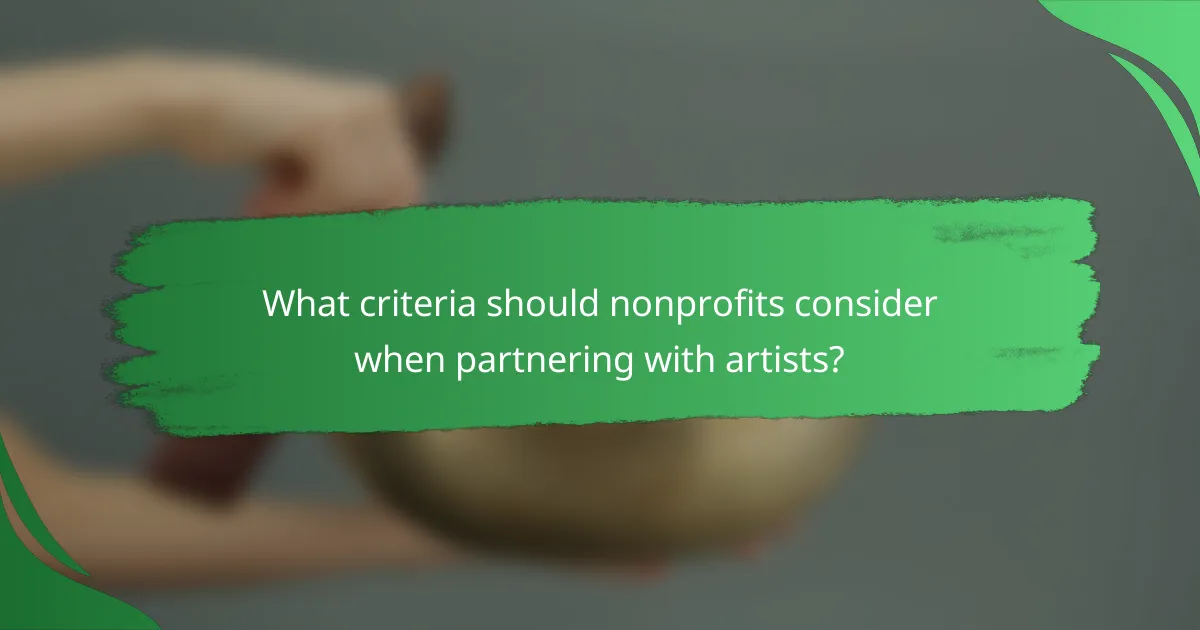
What criteria should nonprofits consider when partnering with artists?
Nonprofits should evaluate several key criteria when partnering with artists, including mission alignment, community impact, and the artist’s reputation. These factors ensure that the collaboration is mutually beneficial and resonates with the nonprofit’s goals.
Alignment of mission
Ensuring that the artist’s vision aligns with the nonprofit’s mission is crucial for a successful partnership. This alignment fosters a shared purpose, which can enhance the effectiveness of initiatives and outreach efforts. For example, a nonprofit focused on environmental conservation may seek artists who create works that highlight ecological issues.
Nonprofits should assess the artist’s previous work and public statements to gauge compatibility. A clear understanding of both parties’ objectives can help avoid conflicts and enhance collaboration outcomes.
Artist’s community impact
The potential impact of the artist on the community is another important consideration. Artists who have a history of engaging with local populations can bring valuable insights and foster deeper connections. Nonprofits should look for artists who have demonstrated a commitment to social issues relevant to their mission.
Evaluating past projects can provide insight into how the artist engages with the community. Nonprofits might consider artists who have successfully collaborated on similar initiatives, as this experience can lead to more effective partnerships.
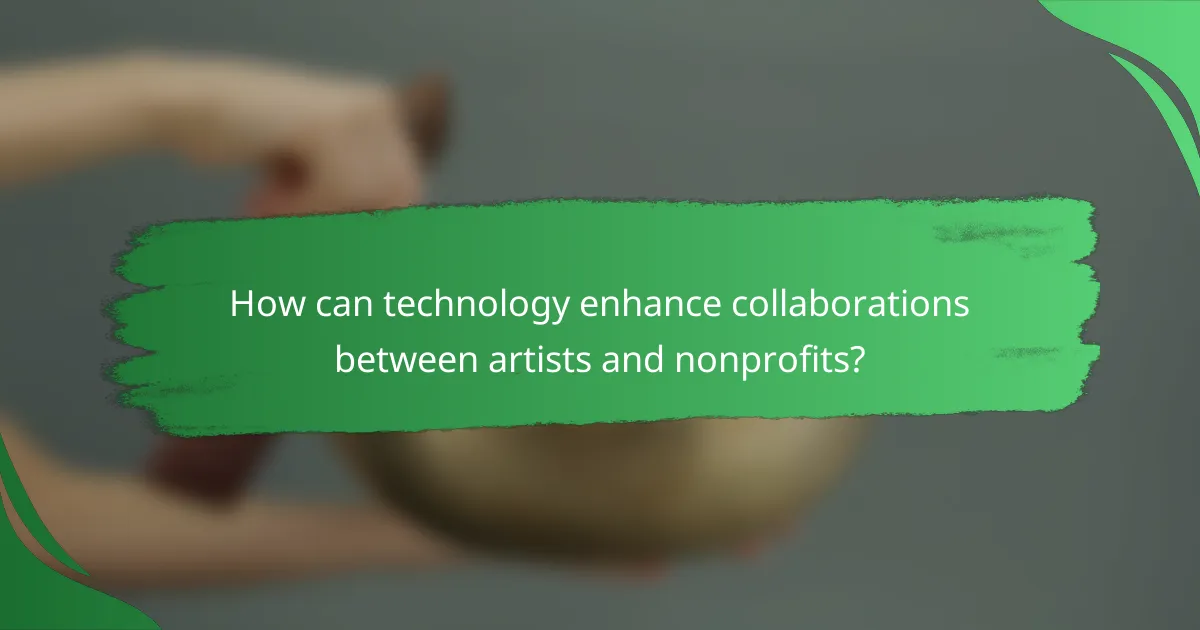
How can technology enhance collaborations between artists and nonprofits?
Technology can significantly improve collaborations between artists and nonprofits by facilitating communication, streamlining project management, and expanding outreach. Tools like social media, project management software, and crowdfunding platforms enable these entities to work together more effectively and reach larger audiences.
Communication Tools
Effective communication is crucial for successful collaborations. Platforms like Slack, Zoom, and Microsoft Teams allow artists and nonprofit organizations to share ideas, provide feedback, and hold virtual meetings seamlessly. Utilizing these tools can help maintain clarity and foster a collaborative environment.
Project Management Software
Project management software such as Trello, Asana, or Monday.com can help artists and nonprofits keep track of tasks, deadlines, and responsibilities. These tools provide a visual overview of project progress, ensuring everyone stays aligned and accountable. Regular updates and check-ins through these platforms can prevent misunderstandings and keep projects on schedule.
Online Fundraising Platforms
Online fundraising platforms like Kickstarter, GoFundMe, or Patreon can help artists and nonprofits raise funds for collaborative projects. These platforms allow for easy sharing of project goals and updates, encouraging community support. Setting clear funding goals and offering incentives can enhance engagement and increase the likelihood of reaching financial targets.
Social Media Outreach
Social media is a powerful tool for promoting collaborations between artists and nonprofits. By creating engaging content and sharing stories about their projects, they can attract a wider audience and potential supporters. Regularly posting updates, behind-the-scenes content, and success stories can help build a loyal following and encourage donations.

